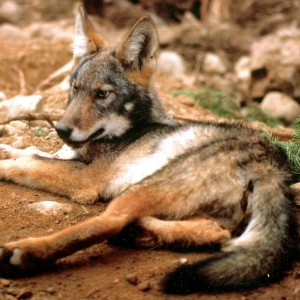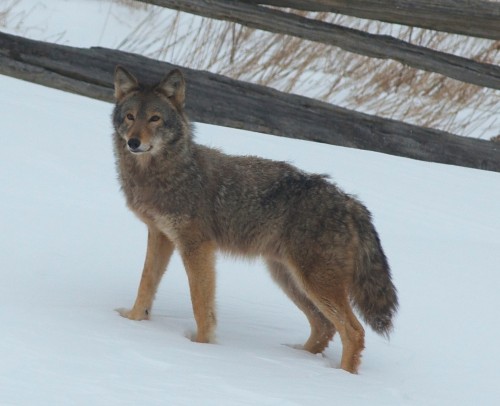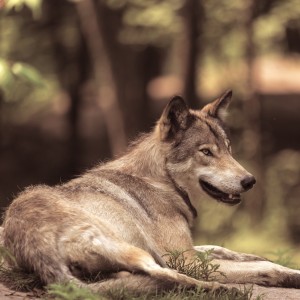
Eastern Wolf
- Scientific Name: Canis lupus (most grey wolves in eastern North America share some eastern wolf DNA - Canis lupus x lycaon)
- Status in Canada: ‘Not At Risk’
- Status in Ontario: ‘Not At Risk’
- Population Size: ~9,600 in Ontario, 50 - 60,000 in Canada
- Distribution: northern Ontario
- Weight: 27 - 45 kg, sometimes larger (up to 80 kg)
- Coat Colour: colour phases range from white to black, but are commonly seal grey
- Primary Prey: moose, white-tailed deer and beaver; elk, caribou and bison where available
- Scientific Name: Canis c.f. lycaon
- Status in Canada: recommended for up-listing from ‘Special Concern’ to ‘Threatened’
- Status in Ontario: ‘Threatened‘ (AKA Algonquin wolf)
- Population Size: ~ 500 total
- Distribution: unknown but likely restricted to remote central Ontario and western Quebec
- Weight: 20 - 35 kg
- Coat Colour: variable but generally reddish brown with black and grey guard hairs
- Primary Prey: white-tailed deer, moose and beaver
Wolves are social animals
Two of the most iconic characteristics of wolves are related to their social nature: cooperative breeding and cooperative hunting. Both species of wolves typically live in packs – groups of related individuals. There is usually only one breeding pair within the pack, often termed the alpha pair. The rest of the wolf pack is made up of related family members – offspring and sometimes siblings of the breeding pair. The breeding pair is usually unrelated – wolves regulate their own diversity if they are able to find unrelated animals to breed with on the landscape. The pack is a dynamic group, and takes part in both the yearly raising of pups and hunting activities. Pack members spend a great deal of time socializing with other family members, and display great variation in temperament, or personality.
Cooperative Breeding
The breeding pair, usually monogamous, asserts its dominance over other members in the pack in an effort to prevent other wolves in the pack from mating. Without enough prey, multiple pup litters would not survive. Where prey is very abundant, it is more common to see 2 litters of pups within a pack.
The breeding pair spends a lot of time in courtship leading up to their mating, which generally occurs in February depending on where the wolves live. Pups are born about 63 days later in a den that may have been used many times by the same pack (perhaps even for hundreds of years). Born deaf and blind, they remain in the den for about 3 weeks before emerging and learning to play, hunt and travel with various members of the pack over the next several months. Females other than the breeder are known to lactate and cooperatively nurse pups within their pack. The whole pack is engaged in raising the pups; to wolves, family is everything.
As the pups age and the pack begins to travel further from the den as a group to hunt, pups are often moved to areas called rendezvous sites where they will be protected while most if not all adult pack members are away hunting. Pups begin travelling with the pack members on hunts in the autumn and winter, learning cooperative hunting techniques needed to become important contributors to the pack health in the future. Over the next year, pups may disperse from their pack, searching for new territory and potential mates in the surrounding landscape. Those individuals who remain with their parental pack often assume den preparation and babysitting duties for the pups born the following spring. In this way, the great family cycle continues.
Cooperative hunting
Wolves regularly prey on large ungulate species, such as deer and moose. It is both dangerous and difficult to approach and kill adult prey, requiring extreme vigilance and excellent communication between members of the pack. The relationship between wolves and their prey is one that is well-studied. A well placed kick from an adult moose is enough to kill a wolf, so it makes sense to choose prey wisely. Research shows that wolves prey on old, sick and injured prey, likely because they pose fewer dangers to the wolves and are easier to take down. This helps regulate prey populations. However, wolves commonly scavenge animals killed during harsh winters, locating animals buried under snow drifts by scent. Their powerful jaws help them consume frozen meat.
In order to kill adult moose and other prey animals, wolves must work together. Hunting success varies with geography and season, but most hunting attempts are unsuccessful. Long-term studies conducted in Alaska tell us that hunting techniques are passed down from more experienced family members, lending certain packs particular hunting techniques that help increase their success according to which and how many prey species inhabit their territory. Hunting and trapping pressures that disrupt wolf packs by killing most or all of the adult members reduces the likelihood that these techniques are taught to younger wolves within the pack. This is likely part of the reason that certain wolf packs begin to prey upon livestock, which are generally much easier to hunt than more widespread and vigilant wild prey.
Wolf communication
Wolves rely on many senses to communicate with family members as well as with other wolf packs. A wolf pup’s senses are fully developed after 5 weeks of age. Although wolves whimper, bark, growl and yip, howling is perhaps their most infamous method of communication. Noted wolf biologist, L.D. Mech stated that wolves are capable of hearing sounds as much as 10 km away in forested habitat, and even further in open tundra. Wolves howl for many reasons: to tell other pack members where they are, to encourage ‘team spirit” before or after a hunt and to warn other packs of their presence.
“Wolves call-howl to family members who have been trapped or shot. They howl in obvious pain and distress while still alive in traps or snares, and so do any other family members on the scene who might be trying to help them. It is not unusual for wolves to return to or remain near a location where close family members have been killed, even after a trapper or hunter has taken the dead wolves away…the emotions that I’ve observed on these occasions in the howling and other behaviour of a wolf near a close mate who had just died were obvious and intense”
- Dr. Gordon Haber, Alaskan wolf biologist
In Algonquin Provincial Park, the stronghold of eastern wolves, over 160,000 people from around the world have participated in the free Public Wolf Howl program held in the park every August. To learn more about Public Wolf Howl events, click here. Wolves have been known to respond to human imitations of wolf howls from 4 kilometres away.
The social nature of wolves is also evident when observing body posturing that emphasizes certain coat colour patterns. Pack hierarchy is constantly tested using various postures of dominance and submission. Recent research also suggests that wolves communicate with their eyes a great deal.
Wolves maintain their territories by scent marking during their travel. A wolf’s sense of smell is 100 times more sensitive than a human’s: they can identify individuals within their pack by smell and can learn if intruders have passed through and marked their territory with urine or scat. Watch these videos collected in the Eastern Wolf Survey: 1 and 2 to see scent-marking communication in action. Non-invasive research methods capitalize on the wolf’s use of trails and prominent crossroads for scent-marking to collect urine and scat for genetic analysis. Learn more about the non-invasive study on eastern wolves in Ontario’s protected areas here.
Western Coyote

courtesy of Charlie Lehoczky
Eastern Coyote
What is the difference between a wolf and a coyote in Ontario?
Prior to the settlement of Ontario by Europeans, Ontario was home to grey wolves in the north, and eastern wolves in the south. However, eastern wolves struggled to survive heavy persecution and habitat loss associated with human settlement. Western coyotes, a species that fared much better in the disturbed landscape and consequently migrated eastward across Canada, bred with what remained of the eastern wolf population in southern Ontario and Quebec. Coyotes in eastern Canada are now called ‘eastern coyotes’ because they have a mixture of western coyote, wolf genes and even dog genes. This helps explain why eastern coyotes (a.k.a. “coywolves”,”brush wolves”, “Tweed wolves”) are larger than western coyotes, and why they are often confused with wolves.
Eastern wolves and eastern coyotes are physically indistinguishable - you can’t tell them apart without a genetic test. To conserve eastern wolves in and around Algonquin Provincial Park, it was necessary to enforce a hunting and trapping ban for both eastern wolves and eastern coyotes. Adding to the confusion is the fact that eastern coyotes and eastern wolves sometimes interbreed, particularly in areas where eastern wolves are harvest (sadly, this happens across much of their range). Given what we know about the eastern wolf’s low odds of surviving outside of areas protected from hunting, trapping and vehicle traffic, the vast majority of canids in the southern parts of our province are eastern coyotes.
Eastern coyotes are much better adapted to living in rural and urban areas, and there are even well-documented populations in Toronto and other heavily populated cities in southern Ontario. Typically, eastern coyotes consume a wide variety of food, including small mammals, insects, and berries. However, like wolves, coyotes depredate on livestock from time to time. Livestock depredation can be mitigated using a variety of non-invasive techniques. Finding the right combination of actions is case-specific – if you are a farmer, please click here for resources on coexisting with wolves and eastern coyotes. To learn more about eastern coyotes, please visit Coyote Watch Canada and Dr. Way’s Eastern Coyote Research.

